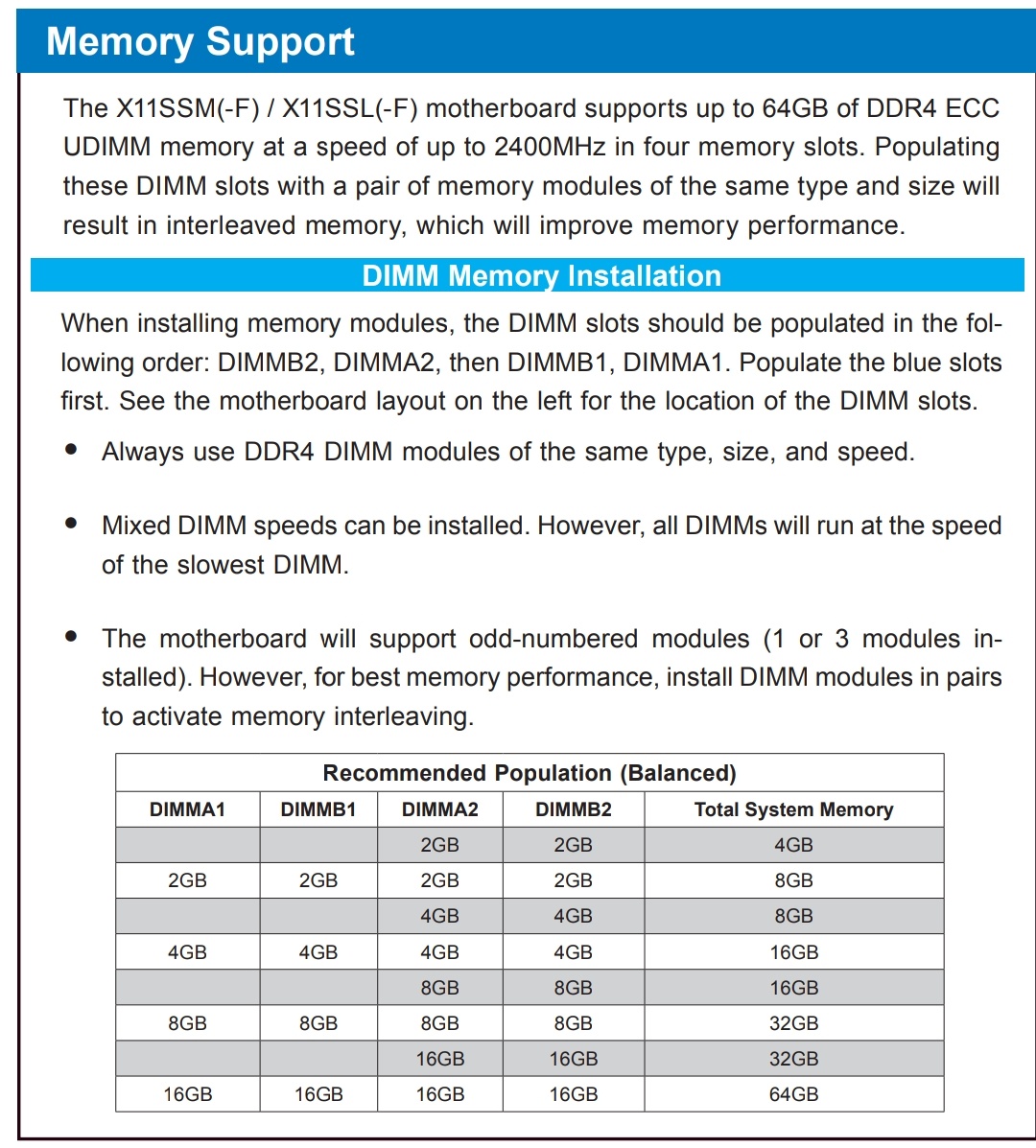luckylinux
Limp Gawd
- Joined
- Mar 19, 2012
- Messages
- 225
I just built a new server out of second hand components (minus the RAM which is new).
- Motherboard: Supermicro X11SSL-F (updated to BIOS 2.6)
- CPU: Intel Xeon E3 1240 V5
- RAM: 4 x Crucial MTA9ASF2G72AZ-3G2B1 (DDR4-3200 ECC UDIMM 1Rx8 CL22)
- PSU: Seasonic G-360
- Cooler: Noctua NH-L12S
All 64GB of RAM are properly detected in BIOS. The RAM runs only at 2133 MHz though (probably CPU limitation).
It never occurred to me before when I was building any other system, but with this one, it boots, but as soon as I enter Debian Linux and try to do some stress test (e.g. compile a Linux Kernel to do a thermal load on the CPU) it just automatically reboots.
Other things I tried:
- Remove some of the DIMMs -> Server refuses to boot (5 short beeps + 1 long beep = no system memory detected)
- Ran Passmark Memtest86 free -> No errors detected in Memtest86 (I only ran it for ~1 hour), but LOTS of Uncorrectable ECC Errors (in all channels/DIMMs) A1/A2/B1/B2
I discovered that while the memory is listed a compatible with Supermicro X11SSL-F on Crucial website, the Motherboard manual states only that:
I assume these were the only memory configurations available when the motherboard came out. Maybe other configurations are also supported ?
Side question: why is my 16GB DIMM listed as 1R8? Shouldn't it be 1R16 since it's a 16GB DIMM?
I will be able to build another similar system in the early future, which (hopefully) will yield a different result, as I cannot determine who is faulty here:
- Motherboard ? No bent pins though ...
- CPU ? Might try to remove cooler, wiggle CPU a bit, and reinstall cooler, maybe that will help a bit
- RAM ? Is the single rank the issue here ?
- PSU ?
Thank you for your help .
.
- Motherboard: Supermicro X11SSL-F (updated to BIOS 2.6)
- CPU: Intel Xeon E3 1240 V5
- RAM: 4 x Crucial MTA9ASF2G72AZ-3G2B1 (DDR4-3200 ECC UDIMM 1Rx8 CL22)
- PSU: Seasonic G-360
- Cooler: Noctua NH-L12S
All 64GB of RAM are properly detected in BIOS. The RAM runs only at 2133 MHz though (probably CPU limitation).
It never occurred to me before when I was building any other system, but with this one, it boots, but as soon as I enter Debian Linux and try to do some stress test (e.g. compile a Linux Kernel to do a thermal load on the CPU) it just automatically reboots.
Other things I tried:
- Remove some of the DIMMs -> Server refuses to boot (5 short beeps + 1 long beep = no system memory detected)
- Ran Passmark Memtest86 free -> No errors detected in Memtest86 (I only ran it for ~1 hour), but LOTS of Uncorrectable ECC Errors (in all channels/DIMMs) A1/A2/B1/B2
I discovered that while the memory is listed a compatible with Supermicro X11SSL-F on Crucial website, the Motherboard manual states only that:
| Max Memory Possible | 4GB DRAM Technology | 8GB DRAM Technology |
| Single Rank UDIMM | 16GB (4x 4GB DIMMs) | 32GB (4x 8GB DIMMs) |
| Dual Rank UDIMMs | 32GB (4x 8GB DIMMs) | 64GB (4x 16GB DIMMs) |
I assume these were the only memory configurations available when the motherboard came out. Maybe other configurations are also supported ?
Side question: why is my 16GB DIMM listed as 1R8? Shouldn't it be 1R16 since it's a 16GB DIMM?
I will be able to build another similar system in the early future, which (hopefully) will yield a different result, as I cannot determine who is faulty here:
- Motherboard ? No bent pins though ...
- CPU ? Might try to remove cooler, wiggle CPU a bit, and reinstall cooler, maybe that will help a bit
- RAM ? Is the single rank the issue here ?
- PSU ?
Thank you for your help
![[H]ard|Forum](/styles/hardforum/xenforo/logo_dark.png)
